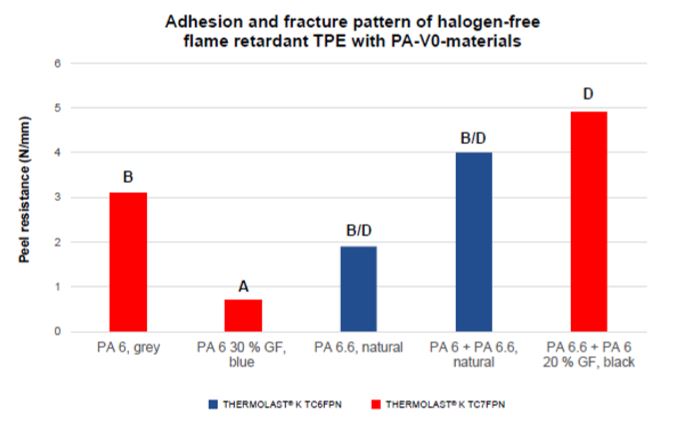
The increasing use of thermoplastic elastomers (TPEs) in multicomponent applications with thermoplastics requires a solid understanding of the influences that affect the adhesion properties. This applies in particular if the hard component is a polyamide and the application requires a high level of fire protection. The following article explains the issue and the state of technology.
For decades, the polyamides market has seen continuous growth, with more and more compounds being modified and optimized according to customerspecific requirements. At the same time, there is a stronger trend toward the integration of functional properties in many application areas that only elastomers provide, such as vibration and sound damping, soft-touch effects, sealing against ambient influences and surfaces that provide good grip.
The immense variety of polyamide types and their various compositions are a special challenge in selecting material for appropriate hard/soft combinations. This applies even more to injection molding applications made of flame-retardant polyamide combined with a thermoplastic elastomer that is also flame-retardant.
Well-established halogen-free flame-retardant properties
Kraiburg TPE has extensive experience in the development of TPEs with halogen-free flame-retardant properties.
A second product series with a V-0 nonflammability classification at wall thicknesses of 1.5mm in accordance with UL standard 94 V-0 has recently been introduced for multi-component applications with polypropylene. A further series with V-0 classification at 3mm has been a successful part of the product line for some time, and the next product series is now about to be launched. Due to high demand, Kraiburg TPE is expanding its portfolio with a flame-retardant PA adhesion series. However, Kraiburg TPE’s specialists faced several challenges in developing these materials. The results of adhesion tests showed a significant spread, which is attributed to different settings and modifications of flame-retardant polyamide formulations.
More than a dozen different PA compounds with UL94 V-2 up to V-0 classification were tested in the course of the development work. As the project progressed, the tests focused on halogen-free flame-retardant materials that are V-0 classified, as these two properties are playing a more and more important role in decisive areas of application such as electrical engineering and electronics.
UL94 V-0 listed materials are self-extinguishing in case of fire and don’t form into burning drops. The materials meet these requirements even without halogenated flame-retardants being used. Kraiburg TPE materials comply with the IEC 61249-2-21 standard’s definition of halogen-free.
If a fire breaks out, this means more safety for people involved, as less disorientating smoke develops and the flue gas is less toxic. In addition, flame retardants that are free of chlorine and bromine minimize the potential risk of damage to furniture and the building fabric caused by corrosive flue gases that develop when halogenated substances are burnt. In addition, their corrosiveness can even have a negative impact on maintaining the properties of old materials and their commercial usability, for example when recycling used cars.
Widely varying test results
The adhesive strength was tested on five specimens of each material combination using a tensile strength testing machine in order to determine the TPEs’ peeling resistance in accordance with the VDI 2019 standard. For the test, the specimen is mounted on a movable carriage and the soft component is pulled vertically upwards via a deflection pulley at a speed of 100mm/min. A peeling resistance of at least 2.5N/mm was set as the target.
As was expected, adhesion testing of TPE/PA combinations provided widely varying results in this flame retardancy range, depending on the polyamide formulation (figure 1). Some polyamides show good adhesion, but in others it is insufficient. The essential factor here is the modification of polyamides with appropriate flame retardants and additives. Cross-checks with TPEs that don’t contain flame retardants and basically show good adhesion to nonflame retardant polyamide types provide similar results. Research carried out by Kraiburg TPE together with selected polyamide manufacturers confirms that the reason why such a TPE/PA combination fails to adhere is to be found in the polyamide.

Figure 1



